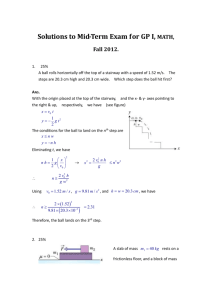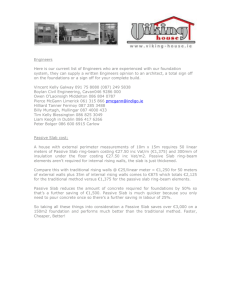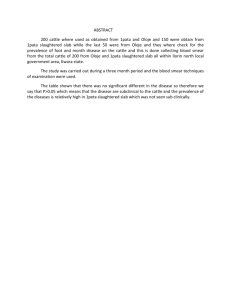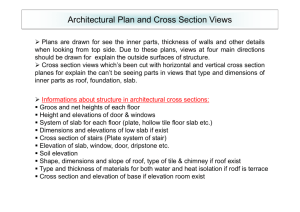Christchurch Foundations Discussion Document
advertisement
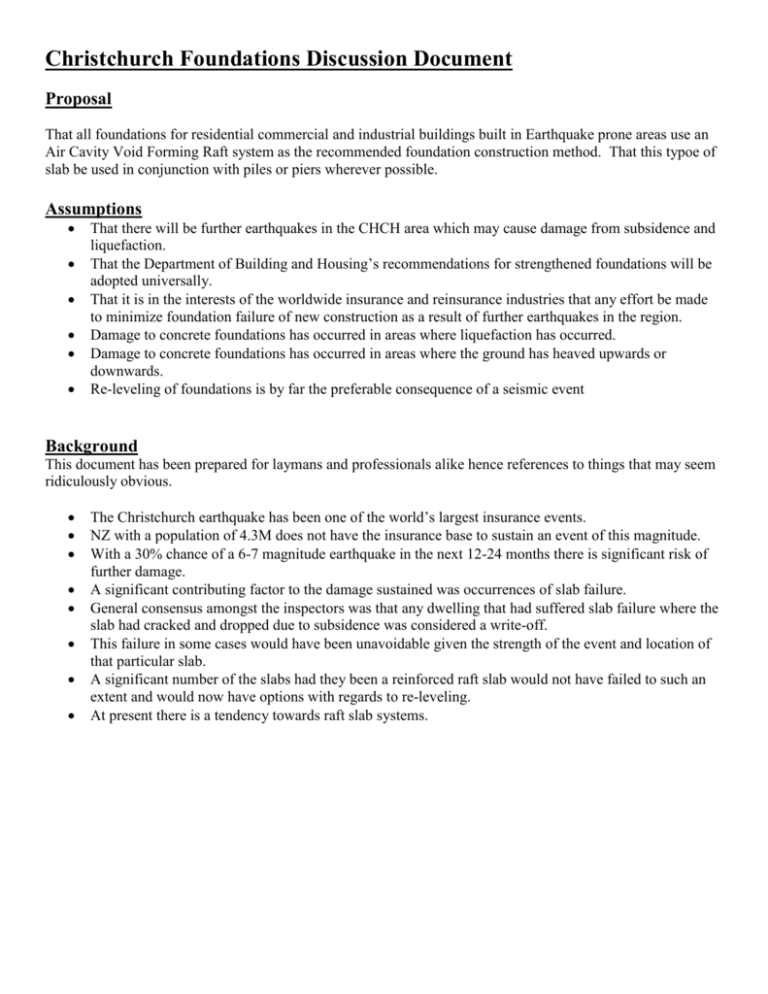
Christchurch Foundations Discussion Document Proposal That all foundations for residential commercial and industrial buildings built in Earthquake prone areas use an Air Cavity Void Forming Raft system as the recommended foundation construction method. That this typoe of slab be used in conjunction with piles or piers wherever possible. Assumptions That there will be further earthquakes in the CHCH area which may cause damage from subsidence and liquefaction. That the Department of Building and Housing’s recommendations for strengthened foundations will be adopted universally. That it is in the interests of the worldwide insurance and reinsurance industries that any effort be made to minimize foundation failure of new construction as a result of further earthquakes in the region. Damage to concrete foundations has occurred in areas where liquefaction has occurred. Damage to concrete foundations has occurred in areas where the ground has heaved upwards or downwards. Re-leveling of foundations is by far the preferable consequence of a seismic event Background This document has been prepared for laymans and professionals alike hence references to things that may seem ridiculously obvious. The Christchurch earthquake has been one of the world’s largest insurance events. NZ with a population of 4.3M does not have the insurance base to sustain an event of this magnitude. With a 30% chance of a 6-7 magnitude earthquake in the next 12-24 months there is significant risk of further damage. A significant contributing factor to the damage sustained was occurrences of slab failure. General consensus amongst the inspectors was that any dwelling that had suffered slab failure where the slab had cracked and dropped due to subsidence was considered a write-off. This failure in some cases would have been unavoidable given the strength of the event and location of that particular slab. A significant number of the slabs had they been a reinforced raft slab would not have failed to such an extent and would now have options with regards to re-leveling. At present there is a tendency towards raft slab systems. Analysis of Alternatives The Christchurch Earthquakes has forced a o Reassessment and reclassification of badly affected suburbs in Christchurch. o Reclassification geotechnical ratings of different suburbs o A re-think of slab design to attempt to cope with subsidence. Given the likelihood of an additional event in the region it would be prudent to build a strategy into foundation design for potential repairs. Any foundation can be engineered to be subsidence proof but the practicality of such a design dismisses this as an alternative except in perhaps hospitals, schools and the like. For residential and light commercial such a design would be cost prohibitive. Foundation design must for residential housing in these areas must balance cost with practicality and where possible mitigate the effects of such subsidence events. Ideally methodology to deal with subsidence should be proven and in evidence prior to construction of the foundation. A balance between responsible design with practicality and price is needed. Both Polystyrene Void Raft Systems (PVRS) and Air Void Raft Systems (AVRS) foundations designs fit this bill. Concrete Slab on grade. (SOG) This was the predominant type of foundation construction used in the Christchurch area for residential and light commercial buildings. In general terms this design has the following characteristics. o The building platform is cut to allow for a finished foundation thickness of approximately 100150mm above natural ground. o A perimeter ring beam foundation id dug of circa 300mm with chaired rebar (reinforcing rods) being a requirement. o A blinding layer of sand or crushed rock is put down followed by a layer of Damp Proof Course or Plastic. o Other than the 300mm deep perimeter beam and thickenings in the slab under load bearing walls the rest of the slab is poured at a depth of 100mm on top of natural ground. o Consequently the slab is generally elevated 100mm from natural ground level. o Average thickness of the slab is circa 130mm o Building regulations of the period did not require significant reinforcing or use of mesh for crack control Positives Historically recognised method of constructing slabs Universally well know method of slab construction. Negatives The historical design as it stood for the majority of foundations in CHCH was not sufficient in strength to allow for heave and subsidence. Generally required two pours one for footings and then the floor. Excessive use of concrete due to basic design Construction of this type of slab difficult in inclement weather. Polystyrene Void Raft System (PVRS). The use of polystyrene void forming pods has been in use with residential and light commercial foundation design for over 20 years. It is a mature system and new designs have been created to comply with the latest DBH recommendation. There are numerous systems available in the NZ market, which use this type of system for concrete foundation construction. In general terms this design has the following characteristics. The building platform is cut to accommodate a foundation with an overall thickness of circa 320mm. A blinding layer of sand or crushed rock is put down followed by a layer of Damp Proof Course Plastic. Formwork is erected around the perimeter of the building to a height of 320mm or higher high depending on the thickness of the topping specified by the engineered design drawings. A ring foundation is incorporated using rebar which is chaired off the ground forming a ring beam of 300mm wide by 320mm again depending on the engineers specification. This ring foundation may have one, two or three single bars or be designed using cage reinforcing depending on the engineered design recommended for that site. Polystyrene pods measuring 220mm high and 1100 square are placed in a grid pattern through the internal area of the slab. These pods are spaced apart by bespoke plastic spacers which also act as a chair for a length of rebar in between pods. The pods are 100mm apart thereby creating a grid pattern of what is essentially 100mm beams crisscrossing the slab. Prior to pouring 665 or 668 mesh is tied onto the top of the pods for crack control. This design is inherently stiff and has good performance characteristics in situations of subsidence and heave as it is able to cantilever a certain distance without cracking should the natural ground support move away from the slab. Like any product Polystyrene has its advantages and disadvantages Positives A flexible material that can be cut to any size. Very light and easy to handle. The system design has excellent strength built in and can be further strengthened with the addition of steel. The design has an average thickness of approximately 110mm a saving of approximately 16% in concrete offset by an increase in steel required. Given the natural stiffness of a polystyrene void raft slab design, if subsidence occurs it should be able to be jacked up and flowable fill pumped underneath. Negatives Transport logistics. Polystyrene is by its nature a voluminous product. A 200m2 concrete foundation requires a full size truck and trailer of polystyrene product to be delivered to site in order to supply. Once on site the pods need to be covered and secured to prevent them from being blown around and off site. When cutting pods which is required where only part of a pod is required, tiny polystyrene balls are a natural byproduct which are near on impossible to collect and pollute waterways. Councils in some areas are now fining building companies caught not controlling the polystyrene waste. To their credit manufacturers of the pods supply large plastic bags when they deliver the pods to site and offer a pick up service of any waste in bags. If clean this product can then be recycled and used to manufacturing new pods. Unfortunately the recycling of material has two issues. o if the recycled material has any soil contamination, it cannot be recycled. o If clean it can be used however only 10% can be used in manufacturing a new pod as it effects the structural integrity of the new pod if a higher percentage is used. Polystyrene act like a sponge where there is water introducing moisture to the underside of a slab. In the event of a major failure of a PVRS foundation requiring demolition, the resulting concrete will be contaminated by the polystyrene and therefore cannot be reused. This will require additional logistics of minimizing environmental impact, transport and a suitable disposal solution. The logistics of transporting house lots of polystyrene into residential areas with truck and trailer units cannot be ignored. Air Void Raft System (AVRS) A void former is used similar to the polystyrene system however rather than being a solid, the former is hollow thereby forming an air void underneath the finished concrete foundation There are a number of companies which market AVRS type products in NZ. The material they are manufactured varies widely Cardboard recycled or virgin Recycled Paper Polystyrene recycled and/or virgin Polyethylene recycled and/or virgin Polypropylene recycled and/or virgin. The reasons for recommending AVRS for all foundation construction in areas prone to earthquakes are numerous hence this discussion document. An Air Void Forming Raft System (AVRS) has similar methodology to that of Polystyrene Raft Slab systems In general terms this design has the following characteristics. The building platform is cut to accommodate a foundation with an overall thickness of circa 300mm depending on the thickness of the topping over the void specified by the engineered design drawings. A blinding layer of sand or crushed rock is put down followed by a layer of Damp Proof Course Plastic. Formwork is erected around the perimeter of the building to a height of 300mm or higher high depending on the thickness of the topping specified by the engineered design drawings. A ring foundation is incorporated using rebar which is chaired off the ground forming a ring beam of 300mm wide by 300mm high again depending on the engineer’s specification. This ring foundation may have one, two or three single bars or be designed using cage reinforcing depending on the engineered design recommended for that site. The void former is then set out in a grid pattern specified by the engineer to take into account load bearing beams and pads where the building design requires them. Reinforcing is specified depending on the performance characteristics of the specific void former used. Prior to pouring 665 or 668 mesh is tied onto the top of the pods for crack control. Given the different designs available each has their own characteristics with regards to strength and can be spec’d up or down depending on soil classification. Positives Better integral strength than a Slab on Grade. In comparison to a Polystyrene Rib Raft slab an AVRS has equivalent integral strength for soils conditions with high heave. Specific design for cantilever ability. Design has natural resistance to cracking built in. Apples for apples AVRS systems use approximately 10-18% less concrete than an equivalent PVRS foundation. If subsidence has occurred like the PVRS the AVRS can easily jacked up and filled with flowable fill. Transport Logistics. As the void formers are hollow they are able to be stacked reducing the transport requirement to site from a truck and trailer to a single hi ab flat deck with perhaps 3-4 pallets of product. Any left over product on site can easily be transported to the next site by the contractor There is near zero waste using some AVRS systems Generally the waste produced by AVRS is recyclable. The air cavity allows access beneath the slab to Inspect the slab and identify areas of subsidence An access point can be cut into the slab to allow insertion of mechanical lifting devices to spread lift to internal parts of the foundation The same access point can be used to introduce stabilizing materials in the cavity beneath the slab. Possible use of the cavity to retrofit post tensioning through the slab for additional support Liquefaction management systems can be constructed into the slab if desired to create a path of least resistance. The cavity can also be used to reroute plumbing if damage occurs to in ground plumbing. Current methods of re leveling of foundations are fully compatible and are in fact enhanced by access to a air cavity underneath an AVRS foundation. The advantages Ability to be used with standard pier or pile techniques. A cost effective alternative whilst being a superior product. Ability for the Cupolex Raft to deal with liquefaction Ability for the Cupolex Raft to accept flowable fill due to the air cavity underneath In order for a raft type slab to be leveled it must have sufficient ground clearance below the slab Without clearance below the raft the flowable fill loses its ability to give support. For example if there is only 20mm of FF below an edge beam its ability to provide Ability to be up-spec’d to a post tensioned slab to prevent cracking. Negatives Market awareness of AVRS foundations is not high therefore a degree of education and training of engineers housing companies and the public will be required. Training of local engineers in the design of the system. Where the AVRS comes into its own and stands above PVRS is the utilization of the air cavity. Scenario 1 A residential dwelling has survived an event with its foundation intact but with subsidence in one area making it 60mm out of level. Slab On Grade (SOG) Using suitable load spreading devices jack up the offending corner of the house. Using formwork form 60mm-zero form work under the slab and pump in flowable fill. The danger being as there is little reinforcing in a SOG for cantilever effect that the slab will crack Another very viable option is to drill holes in the slab and inject an expanding urethane mixture to level the slab. Very cost effective and produces the required results. Polystyrene Void Raft System (PVRS) Using suitable load spreading devices jack up the offending corner of the house. Using formwork form 60mm-zero form work under the slab and pump in flowable fill. As there is generally good reinforcing in a PVRS type foundation it should handle the cantilever effect no problems providing the load of the building is not focused on one point. If the Polystyrene pods have shrunk they will drop out of their cavity when the slab is raised thus may inhibit the flow of flowable fill Given that the weight of the house was supported on the perimeter beam of 300mm and grid beams of 100mm which sunk, flowable fill will create a 60mm-zero concrete plinth beneath the slab. However this thickness may not be sufficiently robust to stop the weight of the house cracking the flowable fill especially as the thickness of the wedge of concrete decreases. By its nature a PVRS slab has a grid of beams. This brings difficulty in using the method of expanding urethane as the polystyrene inhibits the flow and potentially temporarily disguise the lift generated by the urethane. This may result in too much lift being achieved which is another issue entirely. See Appendix 1 and 2 As it is a grid there may need to be multiple penetrations into each grid cavity to spread the urethane lift areas across the slab. Any flowable fill that was pumped under the slab would be questionable as to the support it would be able to provide. o Flowable fill used on a slab on grade is able to spread the load of the building over the full lower face of the slab where it touches the flowable fill. o With a PVRS slab the weight of the building rests on a grid of 1200x1200 beams which have a 100mm load bearing width. As polystyrene is non load bearing all the weight of the building will rest on the beams potentially punching through the flowable fill due to excessive bearing pressure. The compatibility of PVRS foundations with current re-leveling technology comes into question. Air Void Raft System (AVRS) - Cavity under slab The air cavity gives multiple options at this point. Either by using a inspection port (can be located in wardrobes or cupboards) or where no inspections ports exist, by core drilling into a strategic point of the slab, an access point can be attained preferably away from the affected corner of the building. The inspection port must not be the path of least resistance for any urethane injected into the cavity. Initially a camera can be used to inspect all areas under the slab and identify any other issues that may not be visible from the outside. Where liquefaction has occurred beneath the slab thereby inhibiting the use of Urethanes, access to the cavity can be made to accept either mechanical removal of liquefaction or perhaps flushing. In situations where there is a cavity and perhaps sag in the slab at that point an access point may be cut and a mechanical sacrificial lifting device be introduced in order to remove the sag prior to re-leveling. Using the open area under the slab strategic injections of expanding urethane can be utilized to isolate the offending corner of the building. Given an air cavity the expanding urethane will expand into the cavity thereby increasing the load bearing surface for the urethane to expand against and thereby lift the slab. Another option is using suitable mechanical lifting devices to raise the offending corner of the house. Using formwork to form a shutter from 60mm-zero. Then pump in flowable fill. As there is generally good reinforcing in a AVRS type foundation, lifting of the slab in this way should have no adverse cracking. Unlike PVRS, AVRS foundations are fully compatible with current re-leveling technology. Refer Appendix 1 & 2. Piles and Piers It is the recommendation of the writer that Piles or Piers should form a part of any foundation design recommendations. Both PVRS and AVRS foundation designs are compatible with these.



